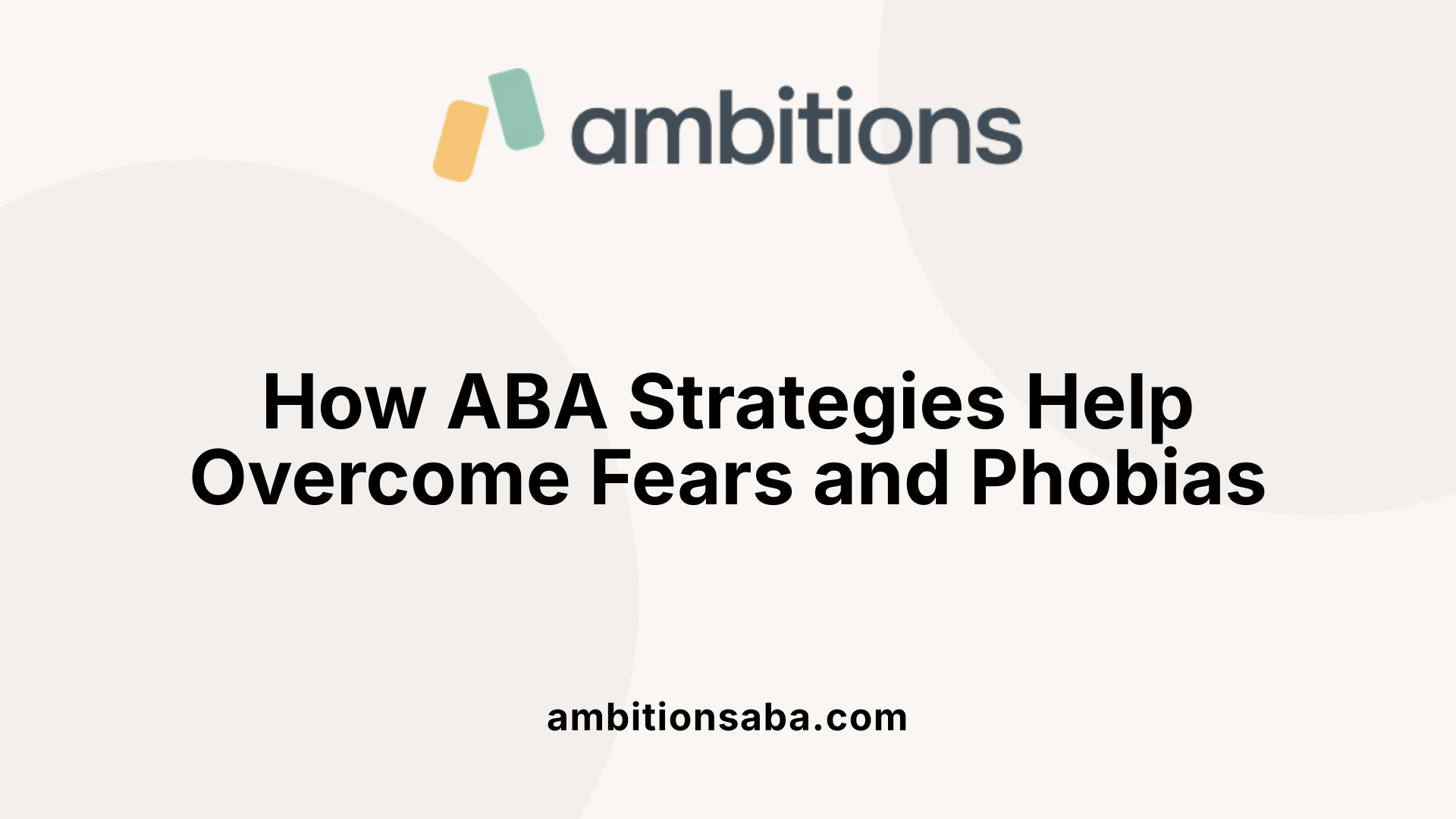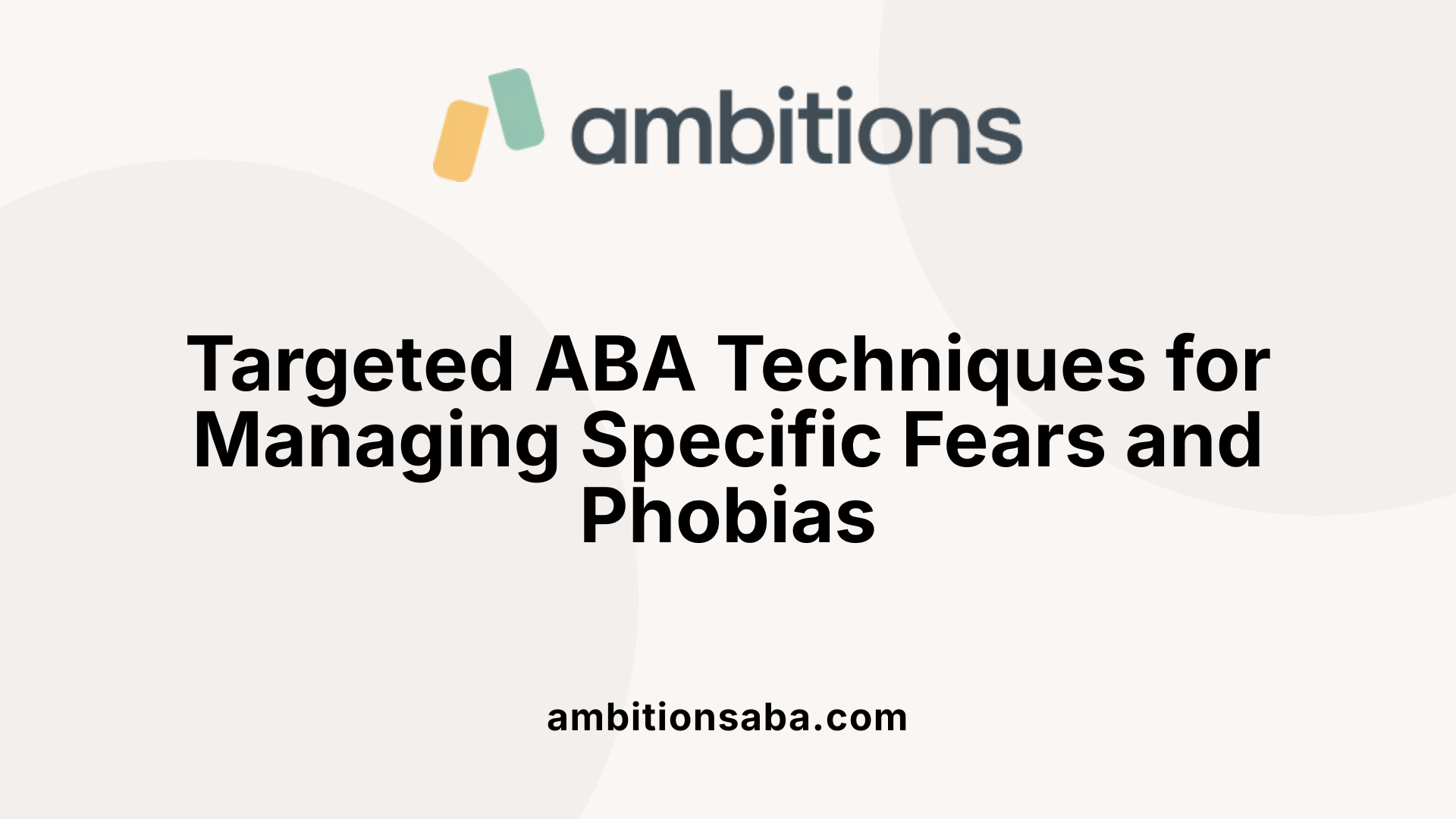Understanding ABA Strategies for Fear Reduction
Fear and phobias are common among children with autism, often leading to heightened anxiety and social withdrawal. Applied Behavior Analysis (ABA) offers effective, evidence-based techniques to systematically address and reduce these fears. This article explores how ABA strategies, especially graduated exposure therapy, construct tailored interventions, and incorporate modern tools like virtual reality, to help individuals manage their anxieties effectively.
Foundations of ABA in Fear Treatment

How do ABA strategies address fears and phobias?
Applied Behavior Analysis (ABA) uses structured and personalized approaches to reduce fears and phobias. Central to this method is graduated exposure therapy, where individuals are gradually introduced to feared stimuli in a safe, controlled setting.
The process begins with simple, non-threatening stages, such as discussing the feared object or watching relevant videos. As confidence builds, exposure progresses to observing from a distance and, eventually, direct contact with the stimulus. This step-by-step approach helps break down irrational fears, making the experience less intimidating over time.
ABA frequently combines exposure with relaxation techniques and cognitive-behavioral strategies, such as challenging negative thoughts related to the fear. Reinforcement plays a critical role; for example, rewarding approach behaviors encourages individuals to further confront their fears.
Modern tools like virtual reality are also employed to simulate scenarios closely, providing immersive yet safe exposure. The overall goal of these strategies is to help individuals develop tolerance, diminish avoidance, and establish new, positive associations with previously feared situations or objects.
How can ABA techniques help manage or eliminate fears?
ABA techniques reduce fears by systematically exposing individuals to the feared stimuli while reinforcing adaptive responses. This gradual approach allows children and adults to build confidence and resilience, decreasing anxiety and avoidance behaviors.
In addition to exposure, ABA incorporates various supportive methods. Visual supports like charts or storyboards help clarify expectations and reduce uncertainty, which often triggers anxiety. Social stories describe feared situations in a calm, positive manner, helping children understand and prepare for real encounters.
Cognitive restructuring tasks, relaxation training, and role-playing can teach coping strategies and emotion regulation skills. Functional Communication Training (FCT) enables individuals to express their needs and fears effectively, thereby reducing frustration and emotional distress.
Because each individual’s fears are unique, ABA employs data collection and progress tracking. Therapists tailor interventions based on ongoing assessments, maximizing effectiveness.
In summary, ABA integrates behavioral and cognitive techniques, providing a comprehensive strategy to diminish fears and promote emotional stability, especially in children with autism.
How do ABA strategies address fears and phobias?
| Strategy | Description | Supporting Techniques | Example |
|---|---|---|---|
| Graduated Exposure | Stepwise exposure to feared stimuli | Relaxation techniques, reinforcement, cognitive-behavioral methods | Starting with watching videos, progressing to real interaction |
| Visual Supports | Use of charts and storyboards | Reduce uncertainty and promote understanding | Visual schedules for feared routines |
| Social Stories | Narrative-based explanations | Clarify situations and behaviors | Stories about visiting the doctor |
| Reinforcement | Positive rewards for approaching | Increase approach behaviors | Praise or tokens for safe proximity |
| Functional Communication Training | Teaching expression of needs/emotions | Reduce frustration and anxiety | Teaching a child to say |
Structured Exposure Techniques within ABA

What does graduated exposure therapy involve?
Graduated exposure therapy is a systematic approach used within ABA to reduce irrational fears and anxieties. It involves constructing a hierarchy of feared stimuli, starting with the least threatening aspects and gradually progressing to more intense or direct encounters. This step-by-step process helps children and adults build tolerance, lessen fear responses, and increase comfort in facing their fears.
For example, a child with autism who fears contact with people with colds may initially look at pictures or watch videos of people with colds. As they become more comfortable, they observe the person from a distance. In later stages, they might interact directly, guided and reinforced by their therapist. This gradual exposure, combined with relaxation techniques and cognitive behavioral strategies, proves effective in diminishing anxiety.
How is reinforcement used to encourage approach behaviors?
Reinforcement plays a crucial role in ABA's exposure methods. Therapists provide positive feedback when children approach or stay near feared stimuli, which encourages repeated approach behaviors. For instance, a child who hesitates to touch a toy representing a feared object may be rewarded with praise, a preferred activity, or tangible rewards upon successful contact.
In a study with Rich, an 8-year-old with autism and a fear of animatronic figures, systematic exposure was paired with positive reinforcement. When Rich approached the stimuli, he received reinforcement, which increased his willingness to get closer over time. The absence of escape strategies and allowing the child to leave perceptions of the stimuli at any time helped build positive associations without distress.
Application of exposure techniques beyond phobias
Graduated exposure isn't limited to simple fears or phobias. It’s also used to help children with autism expand food preferences, lessen sensitivity to sensory input, or overcome social anxieties. Visual supports like storyboards or social stories aid understanding and reduce uncertainty during exposure. Combining presence in real environments with virtual reality tools enhances immersion, making the process safer and more controlled.
Effectiveness and research support
Studies show that contact desensitization and exposure strategies utilizing reinforcement can significantly decrease fear responses in children with developmental disabilities. The research confirms that most target fears are substantially reduced or eliminated after intervention, often accompanied by a decline in related challenging behaviors.
In one example, Rich's continued tolerance of contact stimuli in community settings demonstrated the lasting benefits of graduated exposure. Such results support the continued use of these techniques as evidence-based practices.
| Strategy | Description | Evidence of Effectiveness |
|---|---|---|
| Systematic desensitization | Exposure starts with least threatening stimuli, advancing gradually | Significant reduction in fear responses |
| Reinforced approach | Positive reinforcement for approaching stimuli | Increased approach behaviors over sessions |
| Virtual Reality Exposure | Uses immersive VR scenarios to simulate feared contexts | Effective in reducing anxiety related to phobias |
| Visual supports | Charts, storyboards to explain fears and steps | Reduced uncertainty and anxiety |
How tailored are ABA interventions?
Since fears vary widely among children with autism, interventions are customized to individual needs. Incorporating parental participation ensures reinforcement at home and consistency in intervention. Therapists often combine exposure with other strategies like functional communication training (FCT) to teach children to express their discomfort and needs effectively, reducing frustration and fear.
Overall, ABA offers a flexible, scientifically supported framework to help children face fears safely and successfully, fostering resilience and improving quality of life.
Effective ABA Interventions for Specific Phobias

What ABA strategies are used for managing specific fears or phobias, including conditions like agoraphobia in the context of autism?
Applied Behavior Analysis (ABA) employs several targeted strategies to help children with autism manage and overcome specific fears and phobias. One of the most foundational techniques is gradual exposure, also known as systematic desensitization. This approach involves carefully and slowly introducing the feared stimulus in a controlled way, starting with highly manageable steps such as talking about the object or watching videos, and gradually progressing towards direct encounters.
Contact desensitization, a variation of exposure therapy, focuses on reinforcingapproach responses rather than escape. For example, a child might be positively reinforced for approaching or touching a feared object, like an animatronic figure, leading to increased proximity over sessions.
In addition, visual supports like storyboards and charts simplify understanding, reduce uncertainty, and alleviate anxiety. Functional Communication Training (FCT) is also used to teach children effective ways to express their needs and feelings, minimizing frustration and related fears.
In cases of agoraphobia—an intense fear of open or crowded spaces—ABA strategies include gradual, hierarchically structured exposure to different environments, reinforced with positive feedback. Combining ABA techniques with other interventions such as virtual reality exposure (VRE) helps simulate situations in a safe setting, which can improve generalization to real-world scenarios.
Incorporating sensory-friendly modifications and social stories further supports children by easing sensory overload and providing predictable routines, making exposure less distressing. When tailored to the child's specific needs, these multidimensional approaches offer a robust means to address fears effectively.
How do modified cognitive-behavioral techniques augment ABA approaches in autism treatment?
Modified cognitive-behavioral therapy (CBT) complements ABA by targeting both behavioral and emotional components of fears. In children with autism, these techniques include relaxation training, cognitive restructuring, and virtual reality exposure, which help children understand and regulate their emotional responses.
By addressing physiological reactions and thought patterns associated with fears, modified CBT helps to diminish panic responses and build resilience. This integration supports children in developing adaptive coping strategies, improving their ability to handle anxiety triggers both within therapy and in everyday life.
When combined with ABA strategies, these techniques foster emotional regulation, enhance understanding of fears, and promote the generalization of skills across different environments. The synergy of behavioral reinforcement and cognitive restructuring results in more comprehensive and lasting reductions in phobic reactions.
This combined approach supports children not only in confronting fears but also in understanding their emotional states, leading to improved confidence and independence. Overall, the integration of CBT modifications within ABA frameworks provides a more holistic treatment for fears and phobias in children with autism.
Empowering Children and Families
The use of ABA strategies in addressing fears and phobias in children with autism demonstrates a promising avenue for reducing anxiety and improving quality of life. By tailoring interventions like graduated exposure, systematic desensitization, and utilizing technological advancements, therapists can foster confidence, resilience, and emotional regulation in their clients. Active parental involvement and ongoing research continue to refine these approaches, making them more effective and accessible. As understanding of anxiety and phobia management deepens within the ABA framework, children and their families are better equipped to confront fears and thrive in diverse settings.
References
- What is Graduated Exposure? ABA Techniques, Treating Autism
- How Phobia Impacts Individuals with Autism - SkyCare ABA
- How ABA Therapy Can Help Autistic Children Manage Fears
- Shaping Approach Responses as Intervention for Specific Phobia in ...
- A Systematic Review of the Treatment of Fears and Phobias Among ...
- Understanding and Addressing Agoraphobia in Children with Autism
- How ABA Therapy Helps Children Overcome Fears and Anxieties?
- The Impact of ABA Therapy in Addressing Phobias and Fears in ...



